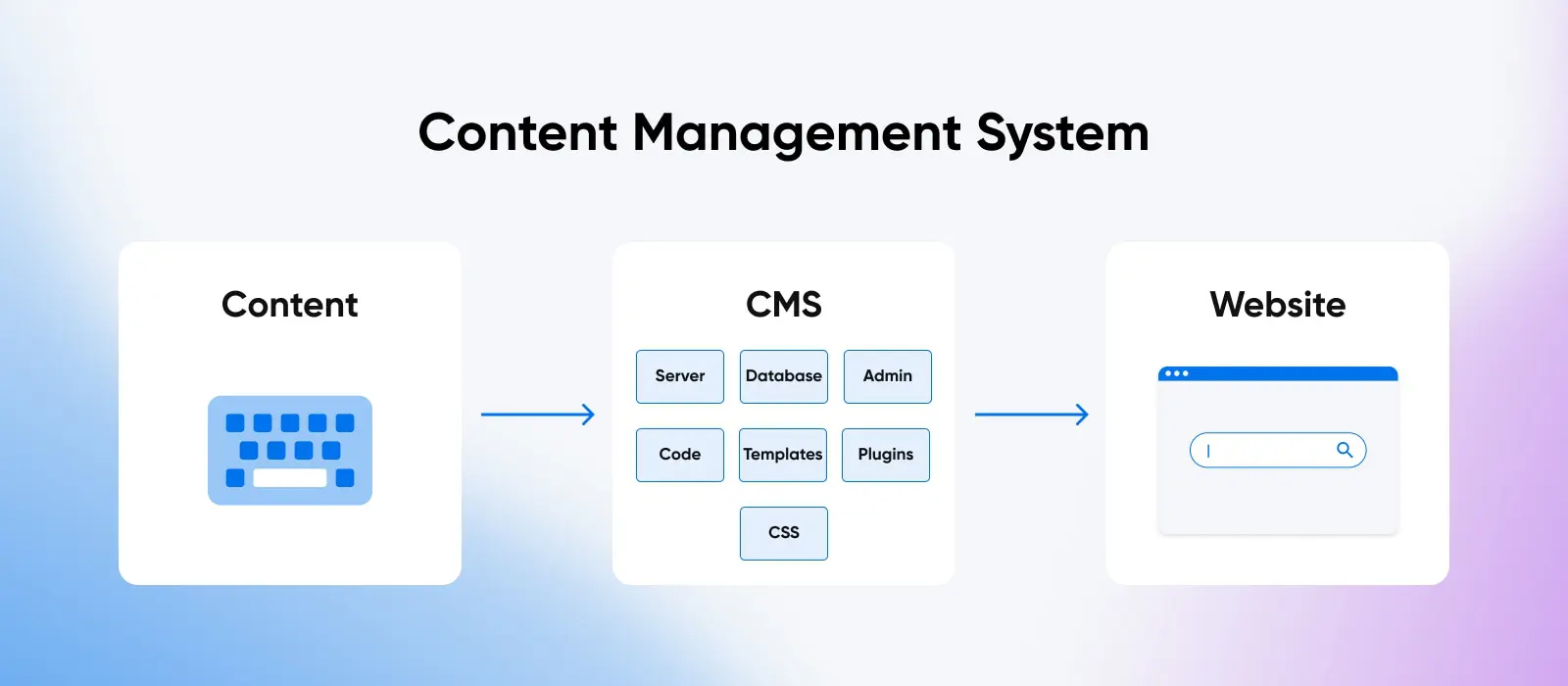If you haven’t looked at the now-famous (or perhaps infamous) map of marketing technology and gasped at the thousands upon thousands of solutions at our fingertips today, you’re a better marketer than I.
Hundreds of these solutions fall into one very important category for businesses and the marketers who help make them successful: content management systems (CMSs).
If you’re not yet working with a CMS, or haven’t found one that makes life easier and business better, this is the guide for you.
Here, we’ll dive deep into:
- The ins and outs of content management systems
- Why businesses should invest in CMS
- The best CMS features to shop for
- Top content management systems on the market
- How to get started with a CMS
Introduction to Content Management Systems
Content management system software typically gives business users an approachable interface where they can create, publish, manage, and store content — without having to touch a line of code — according to their content marketing strategy.
For content creation, most modern CMS platforms provide a WYSIWYG editor (pronounced wiz-ee-wig), which stands for “what you see is what you get.”
WYSIWYG Editor
WYSIWYG is an acronym that stands for ‘what you see is what you get.’ In web design, this typically refers to a web-building interface that allows users to edit their website using an interface that instantly shows the end result.
Read MoreWYSIWYG editors enable folks who work with content to create and format posts and pages without using code. They also display content very close to how it will look once it’s live on the website. This is a vast improvement over the pre-CMS days, when content was hosted via static HTML files that had to be uploaded to the server every time a change was needed.
CMSs typically consist of two core elements:
- Content Management Application (CMA): The part content administrators interact with (like the WYSIWYG editor) to add and manage content.
- Content Delivery Application (CDA): The back-end functionality that stores and displays content to website visitors.
Modern CMSs enable multiple people to work on the same content project, at the same time, with helpful collaboration settings and override preventions. In addition, content is kept secure and compliant thanks to built-in CMS attributes, and real-time content updating helps keep your team abreast of updates and improvements.

One significant thing to note is the several different types of CMS software. While they’re all similar in their general functionality, each has different features and target audiences.
Web Content Management System (WCMS)
WCMSs are built to make it easy to create and maintain content and graphics on websites — taking things like various browser capabilities, screen sizes, and website-specific compliance and regulation issues into account.
When someone mentions CMS, WCMS is what they’re most often referring to. In this article, unless otherwise specified, we’ll also be talking about web-focused CMS tools.
A WCMS is ideal for a brand that primarily focuses on its website as its primary marketing channel.
Component Content Management System (CCMS)
A CCMS is a solution that manages content in components such as singular words, paragraphs, graphic elements (photos, video, etc.), and so on. These components are labeled with unique metadata so that they can be stored in an organized manner, found in a search, and easily reassembled and reused across different publications and web pages.
Since CCMS platforms make content recycling so easy, they’re most helpful for teams with high content creation needs but more limited resources — such as within small businesses.
Headless Content Management System
A Headless CMS disconnects how digital content is presented, known as the front-end or presentation layer, from how content is managed, known as the back-end or management layer. This makes it easy for content managers and marketers to format and deploy content to different digital channels.
Headless CMS is ideal for businesses with robust omnichannel content strategies.
Content Delivery Platform (CDP)
A CDP is actually a content hub versus a CMS. However, since they’re often used alongside CMSs, they’re absolutely worth including here. A CDP gathers different kinds of content from various sources and stores it all in a single location. Businesses can connect to CDPs via an application programming interface (API) to deliver content to custom or out-of-the-box CMS platforms.
API
An Application Programming Interface (API) is a set of functions that allows applications to access data and interact with external components. An API is essentially a courier that delivers messages from a client to a server and vice versa.
Read MoreCDPs are a great fit for organizations with a lot of different content from many different sources, which all need to be shared across several internal and external platforms. Big content distributors, such as media companies and enterprises, can get a lot of use out of CDPs.
Key CMS Features
While a CMS platform is undoubtedly the core of an effective marketing website, thanks to the power and functionality of modern solutions, a CMS can also be core to your entire online presence. You can use it to build everything from a personal blog or portfolio to a fully-fledged online store, membership site, online course, and beyond.
To simplify things, think of creating a website like building a house. The CMS is akin to the essentials, such as the foundation, walls, plumbing, and electric. It ensures that the basics are in place so you can focus on furnishing it, decorating the interior, and making it habitable. In other words, populating your site with content, changing its appearance, and making it easy to interact with.
While every CMS is different, here are some essential features and functionality we recommend prioritizing when choosing your website solution:
- Ease of Use: A big selling point for CMS is its ease of use. As a marketer, you shouldn’t need to understand coding to build an engaging digital experience via a CMS platform.
- Extensibility and Flexibility: With the CMS providing the basics, you should be able to build on the flexible foundation through add-ons that deploy dynamic, unique functionality. Your CMS should enable you to extend core features by installing plugins or introducing your own custom code.
- Powerful Content Handling: Today, content is more than just the written word. You also need images, videos, forms, and document management to make your content engaging. Your CMS should support all of these types of content.
- Content Management Workflows: Easy editing, fast styling, quick content updates, version control and backup, scheduling, searching, storage, and more — a practically unimaginable variety of content management features and flows should live at the center of your CMS.
- Drag-and-Drop Design: Most modern CMSs make it easy to use your mouse to drag design components into place for real-time content design.
- Permission Control: It’s crucial for security and consistency that you can assign user roles to ensure everybody can access the content and functionality necessary to do their jobs (and no more).
- Support: Whether it’s in the form of documentation or a real-life support team, it’s always ideal to work with a CMS that doesn’t leave you out on your own if something goes wrong.
- Scalability: Most sites grow over time, both in how much content they include and how many visitors they receive. As such, you want a CMS that’s built to be scalable along with your site’s needs.
- Open API: An open API makes it possible to pull content from your CMS to reuse it on external websites, mobile apps, social media sites, etc., as well as internal platforms like enterprise resource planning (ERP) software, customer relationship management (CRM) software, etc.
- Templates: Choose a CMS platform with several premade templates that can be easily applied to change the look and behavior of your site.
- Search Engine Optimization: An SEO-friendly CMS will feature customizable page titles, meta descriptions, smart URLs and navigation, alt text, redirects, and quick page load time to help your ranking on Google and other search engines.
4 Top Content Management Systems for Creating Websites
Let’s explore today’s go-to CMS solutions for creating a website and managing content flawlessly.
WordPress

WordPress needs very little introduction.
WordPress started as a continuation of the b2 platform, which was developed primarily with bloggers in mind. However, over the past twenty years, the platform has completely evolved into a full-fledged CMS.
WordPress is the most popular CMS option, holding the majority of CMS market share and powering websites for brands like Facebook and Sony.
So, how and why has it become so popular? One significant reason is that WordPress has remained a community-run and open-source CMS. In fact, being open, user-friendly for beginners, and extensible have stayed key factors ever since the project launched in 2003.
In short, WordPress requires next to no prior experience in creating websites. Anyone can install it, build a site, and add content and new features within minutes. The vast number of available plugins and themes to easily change your WordPress site’s appearance also makes it a particularly enticing option. For an extensive list of reasons to go with this solution, don’t miss our guide to why to use WordPress.
Despite the enormous popularity of WordPress, it naturally has a few downsides.
For example, while the core platform itself is secure, it’s a frequent target for bots and attackers. Poorly coded plugins and themes can also introduce security vulnerabilities if you’re not careful.
All in all, WordPress is a solid choice, especially for less-technical, content-focused users. It’s a simple solution for marketers that also offers a lot of power under the hood for developers wishing to get involved with the technical aspects and increase functionality.
WordPress is free to download. (Though if you want a custom domain name, you will have to pay up or consider the self-hosted WordPress.org — learn more about the differences here.)
For a fast and secure website experience for your team and customers alike, DreamHost’s WordPress web hosting service is optimized specifically for businesses running on WordPress.
CMS Hub

From the prolific inbound marketing, sales, and customer service platform HubSpot comes CMS Hub.
CMS Hub boasts all the features you’d expect from any fully-featured content management system: drag-and-drop website builder, staging, blogging and collaboration tools, file management, etc. While it’s easy to use for marketers, developers can take advantage of serverless functions and pre-built themes, and IT gets the benefit of HubSpot’s 24/7 security team.
In addition, CMS Hub users can integrate the rest of HubSpot’s stable of features, from marketing automation, email marketing, CRM, lead forms, chat, reporting, and more— no integrations with third-party solutions required.
This HubSpot CMS is best for companies already using the platform — or those that could make use of all the accompanying marketing, content, sales, and support tools it provides.
Pricing ranges from free to $1,200 a month for enterprise solutions, and hosting and flexible themes are included.
Joomla!

The name Joomla! comes from the Swahili term for “all together,” which references the platform’s open-source community. In contrast to WordPress, Joomla! is a slightly more developer-focused CMS, though it still features a user-friendly interface.
Joomla! has cultivated a vast user community that regularly creates extensions and themes to help bolster the platform’s core functionality. This makes it a good choice if you think WordPress isn’t offering the level of control you require.
The platform’s flexibility also makes Joomla! an excellent choice for more complex websites, such as e-commerce sites, social media networks, and online communities. Naturally (and as we touched on), Joomla! also enables you to download themes and extensions to your site.
Considering the additional complexity of the CMS, it might not be the best option if you have little experience or resources to handle website development.
The learning curve may be steeper with Joomla! if you’ve primarily used a more end-user-focused CMS in the past. However, developers may find it affords them more freedom and flexibility than WordPress’ out of the box configuration.
Joomla! is also completely free to download and use, with no paid plans. While fewer hosts support Joomla! out of the box than WordPress, there are still many who tweak their servers to support the CMS.
Drupal

If Joomla! is a step up in terms of complexity from WordPress, Drupal represents another leap.
Initially released in 2001, Drupal is the most technically advanced CMS on this list, which makes it an ideal choice for businesses with development resources that want complete control over their sites — and need less technical guidance.
As you can probably imagine, Drupal is best suited for advanced and ambitious websites. It’s an extremely versatile platform that lets web development pros create almost any type of site. It’s also arguably the most powerful CMS available and practically guarantees both strong security and fast loading times out of the box.
Because of this, Drupal is a great choice for enterprises with a development team on hand, a need for consistently high speeds and reliability, and the budget to match. It’s also commonly used by governments and universities. The platform also offers extensibility in the form of modules and themes.
Like the previous offerings, Drupal is entirely free to use and based on open-source technology. It will require some tinkering to install and learn the ropes, but getting the level of complexity and freedom the CMS offers can be worth it.
How to Spin Up a CMS Website
The high-level process of creating your own website using a content management system will look a little something like this:
- Choose your CMS based on which best delivers on your needs, based on the above suggestions and feature shopping list.2. Select a web hosting provider to deliver your website’s content and files to the internet. Cloud-based hosting is worth considering if security, speed, performance, and uptime are priorities for your business.
- Get your domain name and registrar set up. Be sure to check if your hosting provider will help or even give you a free domain name as part of your package.
- Install your Content Management System — most platforms provide instructions on how to do this manually. Beware that manual installation will require working with code. Often, your hosting provider can also help with installation.
- Get the CMS set up to your liking by adding fellow teammates, adjusting built-in settings, and adding plugins to extend functionality.
- Start creating and publishing content!
It’s Time to Get Started With a CMS
The days of having to work with code just to update any little piece of content on your website or launch new marketing campaigns are long gone, thanks to the rise of the CMS.
Today, these user-focused platforms enable marketing and business teams to create and publish content much easier while extending their website’s capabilities to suit their unique content requirements.
Choose your DreamHost hosting plan today to take advantage of easy installation, reliable uptime, award-winning support, and a knowledgeable community when spinning up your modern content management system of choice.

Do More with DreamPress
DreamPress Plus and Pro users get access to Jetpack Professional (and 200+ premium themes) at no added cost!
Check Out Plans
